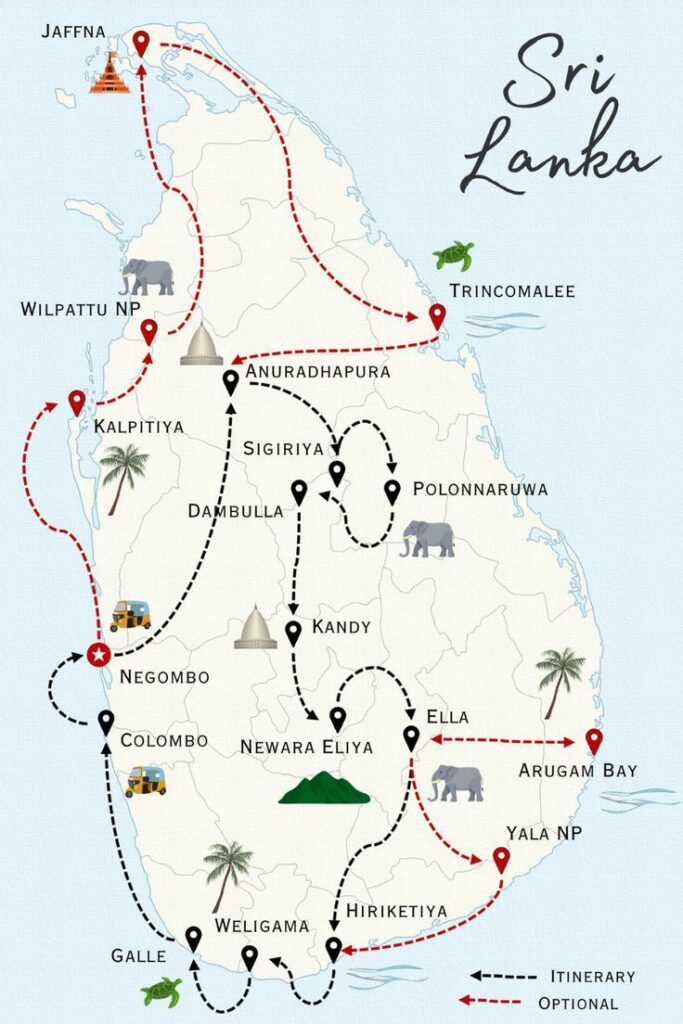Sri Lanka is a vibrant and diverse island offering stunning landscapes, rich history, and warm hospitality. Here’s an essential guide for travelers planning to visit:
- When to Visit

Sri Lanka experiences two monsoon seasons, so the best time depends on the region:
West and South Coasts + Hill Country: December to March
East Coast: April to September
If you’re visiting nationwide, January and February are ideal.
- Entry Requirements
Visa: Most travelers need an Electronic Travel Authorization (ETA), which can be applied online.
Vaccination: No mandatory vaccinations, but ensure you’re updated on general immunizations (e.g., Hepatitis A, Typhoid).
- Key Destinations
Cultural Triangle
Sigiriya Rock Fortress: Climb this ancient fortress with panoramic views.
Dambulla Cave Temple: Admire ancient Buddha statues and murals.
Polonnaruwa and Anuradhapura: Explore ancient ruins and stupas.
Hill Country
Kandy: Visit the Temple of the Tooth and explore Peradeniya Botanical Gardens.
Ella: Hike Little Adam’s Peak, visit Nine Arches Bridge, and enjoy the laid-back vibe.
Nuwara Eliya: Experience cool weather, tea plantations, and colonial architecture.
Beaches
South Coast: Mirissa, Unawatuna, Hiriketiya, and Tangalle are perfect for relaxation, surfing, and whale watching.
East Coast: Arugam Bay for surfing and Passikudah for calm waters.
Wildlife Safaris
Yala National Park: Spot leopards, elephants, and other wildlife.
Udawalawe National Park: Known for elephants.
Minneriya National Park: Witness the “Elephant Gathering.”
Adventure & Nature
Knuckles Mountain Range: Ideal for hiking and nature lovers.
Kitulgala: Try white-water rafting and trekking.
- Transportation
Public Transport: Affordable but can be crowded.
Trains: Scenic routes like Kandy to Ella are popular.
Buses: Extensive network but slower and less comfortable.
Private Transport: Hire a car with a driver for flexibility and convenience.
Tuk-Tuks: Great for short trips within towns.
Domestic Flights: Available between major destinations.
- Food and Drink
Local Cuisine: Try rice and curry, kottu roti, string hoppers, and hoppers.
Seafood: Fresh and abundant in coastal areas.
Drinks: Enjoy Ceylon tea, king coconut water, and fresh juices.
Note: Avoid tap water; opt for bottled or boiled water.
- Culture and Etiquette
Dress modestly when visiting temples (cover shoulders and knees).
Remove shoes and hats before entering religious sites.
Show respect to monks and avoid touching their robes.
Public displays of affection are frowned upon.
- Safety Tips
Health: Carry insect repellent to avoid mosquito bites.
Road Safety: Roads can be busy; drive cautiously or rely on experienced drivers.
Wildlife: Maintain a safe distance and follow park guidelines.
Money: Use ATMs in major towns, and always carry some cash for rural areas.
- Must-Pack Essentials
Lightweight, breathable clothing (but pack layers for the hill country).
Comfortable walking shoes.
Sunscreen, hat, and sunglasses.
Reusable water bottle (to reduce plastic use).
Power adapter (Sri Lanka uses Type D and G plugs).
- Sustainable Travel Tips
Respect wildlife and avoid activities like elephant riding.
Support local businesses and stay in eco-friendly accommodations.
Avoid single-use plastics and dispose of waste responsibly.
- Local Experiences to Try
Take a cooking class to learn Sri Lankan dishes.
Visit a tea plantation to see how tea is produced.
Join a traditional dance or drumming workshop.
Engage in Ayurveda treatments for relaxation.
Sri Lanka offers something for every traveler—be it culture, adventure, or relaxation. Plan your journey thoughtfully and enjoy the charm of this tropical paradise




